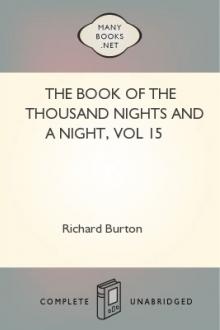The Book of the Thousand Nights and a Night, vol 10 by Sir Richard Francis Burton (highly recommended books .TXT) 📕

- Author: Sir Richard Francis Burton
- Performer: -
Book online «The Book of the Thousand Nights and a Night, vol 10 by Sir Richard Francis Burton (highly recommended books .TXT) 📕». Author Sir Richard Francis Burton
In Santo Domingo the disease was common under the names Hipas, Guaynaras and Taynastizas: hence the opinion in Europe that it arose from the mixture of European and “Indian” blood.[FN#187] Some attributed it to the Gypsies who migrated to Western Europe in the xvth century:[FN#188] others to the Moriscos expelled from Spain.
But the pest got its popular name after the violent outbreak at Naples in A.D. 1493-4, when Charles VIII. of Anjou with a large army of mercenaries, Frenchmen, Spaniards, and Germans, attacked Ferdinand II. Thence it became known as the Mal de Naples and Morbus Gallicus-una gallica being still the popular term in neo Latin lands-and the “French disease” in England. As early as July 1496 Marin Sanuto (Journal i. 171) describes with details the “Mal Franzoso.” The scientific “syphilis” dates from Fracastori’s poem (A.D. 1521) in which Syphilus the Shepherd is struck like Job, for abusing the sun. After crippling a Pope (Sixtus IV.[FN#189]) and killing a King (Francis I.) the Grosse V�role began to abate its violence, under the effects of mercury it is said; and became endemic, a stage still shown at Scherlievo near Fiume, where legend says it was implanted by the Napoleonic soldiery. The Aleppo and other “buttons” also belong apparently to the same grade. Elsewhere it settled as a sporadic and now it appears to be dying out while gonorrh�a is on the increase.[FN#190]
The Nights, I have said, belongs to the days before coffee (A.D.
1550) and tobacco (A.D. 1650) had overspread the East. The former, which derives its name from the K�f� or K�ff� province, lying south of Abyssinia proper and peopled by the Sid�ma Gallas, was introduced to Mokha of Al-Yaman in A.D. 1429-30 by the Shaykh al-Sh�zili who lies buried there, and found a congenial name in the Arabic Kahwah=old wine.[FN#191] In The Nights (Mac. Edit.) it is mentioned twelve times[FN#192]; but never in the earlier tales: except in the case of Kamar alZaman II. it evidently does not belong to the epoch and we may fairly suspect the scribe. In the xvith century coffee began to take the place of wine in the nearer East; and it gradually ousted the classical drink from daily life and from folk-tales.
It is the same with tobacco, which is mentioned only once by The Nights (cmxxxi.), in conjunction with meat, vegetables and fruit and where it is called “T�bah.” Lane (iii. 615) holds it to be the work of a copyist; but in the same tale of Abu Kir and Abu Sir, sherbet and coffee appear to have become en vogue, in fact to have gained the ground they now hold. The result of Lord Macartney’s Mission to China was a suggestion that smoking might have originated spontaneously in the Old World.[FN#193] This is undoubtedly true. The Bushmen and other wild tribes of Southern Africa threw their Dakh� (cannabis indica) on the fire and sat round it inhaling the intoxicating fumes. Smoking without tobacco was easy enough. The North American Indians of the Great Red Pipe Stone Quarry and those who lived above the line where nicotiana grew, used the kinni-kinik or bark of the red willow and some seven other succedanea.[FN#194] But tobacco proper, which soon superseded all materials except hemp and opium, was first adopted by the Spaniards of Santo Domingo in A.D. 1496 and reached England in 1565. Hence the word, which, amongst the so-called Red Men, denoted the pipe, the container, not the contained, spread over the Old World as a generic term with additions, like ��Tutun,”[FN#195] for special varieties. The change in English manners brought about by the cigar after dinner has already been noticed; and much of the modified sobriety of the present day may be attributed to the influence of the Holy Herb en cigarette. Such, we know from history was its effect amongst Moslems; and the normal wine-parties of The Nights suggest that the pipe was unknown even when the latest tales were written.
C.
We know absolutely nothing of the author or authors who produced our marvellous Recueil. Galland justly observes (Epist. Dedic.), “probably this great work is not by a single hand; for how can we suppose that one man alone could own a fancy fertile enough to invent so many ingenious fictions?” Mr. Lane, and Mr. Lane alone, opined that the work was written in Egypt by one person or at most by two, one ending what the other had begun, and that he or they had re-written the tales and completed the collection by new matter composed or arranged for the purpose. It is hard to see how the distinguished Arabist came to such a conclusion: at most it can be true only of the editors and scribes of MSS. evidently copied from each other, such as the Mac. and the Bul. texts. As the Reviewer (Forbes Falconer?) in the “Asiatic Journal” (vol. xxx., 1839) says, “Every step we have taken in the collation of these agreeable fictions has confirmed us in the belief that the work called the Arabian Nights is rather a vehicle for stories, partly fixed and partly arbitrary, than a collection fairly deserving, from its constant identity with itself, the name of a distinct work, and the reputation of having wholly emanated from the same inventive mind.
To say nothing of the improbability of supposing that one individual, with every license to build upon the foundation of popular stories, a work which had once received a definite form from a single writer, would have been multiplied by the copyist with some regard at least to his arrangement of words as well as matter. But the various copies we have seen bear about as much mutual resemblance as if they had passed through the famous process recommended for disguising a plagiarism: �Translate your English author into French and again into English’.”
Moreover, the style of the several Tales, which will be considered in a future page (� iii.), so far from being homogeneous is heterogeneous in the extreme. Different nationalities show them selves; West Africa, Egypt and Syria are all represented and, while some authors are intimately familiar with Baghdad, Damascus and Cairo, others are equally ignorant. All copies, written and printed, absolutely differ in the last tales and a measure of the divergence can be obtained by comparing the Bresl. Edit. with the Mac. text: indeed it is my conviction that the MSS. preserved in Europe would add sundry volumes full of tales to those hitherto translated; and here the Wortley Montagu copy can be taken as a test. We may, I believe, safely compare the history of The Nights with the so-called Homeric poems, the Iliad and the Odyssey, a collection of immortal ballads and old Epic formul� and verses traditionally handed down from rhapsode to rhapsode, incorporated in a slowly-increasing body of poetry and finally welded together about the age of Pericles.
To conclude. From the data above given I hold myself justified in drawing the following deductions:—
1. The framework of the book is purely Persian perfunctorily arabised; the archetype being the Haz�r Afs�nah.[FN#196]
2. The oldest tales, such as Sindibad (the Seven Wazirs) and King Jili’�d, may date from the reign of Al-Mansur, eighth century A.D.
3. The thirteen tales mentioned above (p. 78) as the nucleus of the Repertory, together with “Dalilah the Crafty,”[FN#197] may be placed in our tenth century.
4. The latest tales, notably Kamar alZaman the Second and Ma’aruf the Cobbler, are as late as the sixteenth century.
5. The work assumed its present form in the thirteenth century.
6. The author is unknown for the best reason; there never was one: for information touching the editors and copyists we must await the fortunate discovery of some MSS.
� II.
THE NIGHTS IN EUROPE.
The history of The Nights in Europe is one of slow and gradual development. The process was begun (1704-17) by Galland, a Frenchman, continued (1823) by Von Hammer an Austro-German, and finished by Mr. John Payne (1882-84) an Englishman. But we must not forget that it is wholly and solely to the genius of the Gaul that Europe owes “The Arabian Nights’ Entertainments” over which Western childhood and youth have spent so many spelling hours.
Antoine Galland was the first to discover the marvellous fund of material for the story-teller buried in the Oriental mine; and he had in a high degree that art of telling a tale which is far more captivating than culture or scholarship. Hence his delightful version (or perversion) became one of the world’s classics and at once made Sheherazade and Dinarzarde, Haroun Alraschid, the Calendars and a host of other personages as familiar to the home reader as Prospero, Robinson Crusoe, Lemuel Gulliver and Dr.
Primrose. Without the name and fame won for the work by the brilliant paraphrase of the learned and single-minded Frenchman, Lane’s curious hash and latinized English, at once turgid and emasculated, would have found few readers. Mr. Payne’s admirable version appeals to the Orientalist and the “stylist,” not to the many-headed; and mine to the anthropologist and student of Eastern manners and customs. Galland did it and alone he did it: his fine literary flaire, his pleasing style, his polished taste and perfect tact at once made his work take high rank in the republic of letters nor will the immortal fragment ever be superseded in the infallible judgment of childhood. As the Encyclop�dia Britannica has been pleased to ignore this excellent man and admirable Orientalist, numismatologist and litt�rateur, the reader may not be unwilling to see a short sketch of his biography.[FN#198]
Antoine Galland was born in A.D. 1646 of peasant parents “poor and honest” at Rollot, a little bourg in Picardy some two leagues from Montdidier. He was a seventh child and his mother, left a widow in early life and compelled to earn her livelihood, saw scant chance of educating him when the kindly assistance of a Canon of the Cathedral and President of the Coll�ge de Noyon relieved her difficulties. In this establishment Galland studied Greek and Hebrew for ten years, after which the “strait thing at home” apprenticed him to a trade. But he was made for letters; he hated manual labour and he presently removed en cachette to Paris, where he knew only an ancient kinswoman. She introduced him to a priestly relative of the Canon of Noyon, who in turn recommended him to the “Sous-principal” of the Coll�ge Du Plessis. Here he made such notable progress in Oriental studies, that M. Petitpied, a Doctor of the Sorbonne, struck by his abilities, enabled him to study at the Coll�ge Royal and eventually to catalogue the Eastern MSS. in the great ecclesiastical Society. Thence he passed to the Coll�ge Mazarin, where a Professor, M. Godouin, was making an experiment which might be revived to advantage in our present schools. He collected a class of boys, aged about four, and proposed to teach them Latin speedily and easily by making them converse in the classical language as well as read and write it.[FN#199] Galland, his assistant, had not time to register success or failure before he was appointed attach�-secretary to M. de Nointel named in 1660
Ambassadeur de





Comments (0)